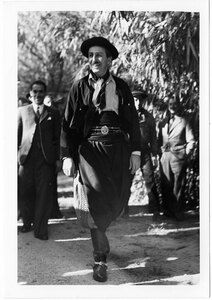Doc uncovers man behind Mickey Mouse empire
We live in a time when Walt Disney’s name is linked to everything from theme parks to mouse ears. But people often forget that the name belonged to a true artist and a man who worked hard — and imagined even harder — to lay the building blocks of what has now become a magnificent empire.
What we see today are Disney’s greatest successes: Disneyland, his countless classic animated films and the joy his legacy continues to bring to so many people. What we don’t often see are the struggles that Disney had to endure and the hardships he had to overcome in order to make his dreams a reality.

El jefe · Disney’s latest documentary, Walt & El Grupo, captures a slice of the brilliant animator’s life unknown to most Disneyland-goers. - Photos courtesy of Walt Disney Studios
Walt & El Grupo, which screened on-campus Wednesday, is a documentary masterfully put together by writer-director Theodore Thomas and his producing partner, Kuniko Okubo. The film gives us a glimpse into one of the toughest periods in Disney’s life — a time when there was not only a world war going on, but also a war within his newly established movie studio.
In 1941, Disney was asked by the US government to take a trip to South America as part of a goodwill tour to win over the Latin countries as allies. The government wanted Disney to simply go and represent the positive aspects of American culture, but as Disney himself says in a sound clip included in the film, he’d “feel better about going down to do something rather than to just shake hands.”
Disney, along with wife Lillian and 16 chosen artists, animators and other employees (including Thomas’ father, Frank), set off on a 10-week trip through Brazil, Argentina and Chile. They went not only to promote goodwill among the Latin Americans, but also to conduct research for future films.
Meanwhile, Disney’s fledgling studio, which had just produced Pinocchio and Fantasia after having monumental success with Snow White, was struggling because finances were constantly being cut due to the war in Europe and a bitter animators’ strike in full swing. But the young, energetic Disney — who was not yet 40 at the time — embarked on his South American adventure nonetheless, hoping that all would be resolved by the time he returned.
And what an adventure it was. Photos, never-before-seen footage, drawings and animation displayed throughout Walt & El Grupo show us Disney learning the samba, dressing up like a gaucho and making friends wherever he went. The story of Disney’s trip bursts with color throughout the film, despite the fact that much of the material used to tell it is in black and white.
Though none of the travelers are still living, filmmakers Thomas and Okubo worked around this difficult challenge by artfully using sons, daughters, spouses and others close to those who accompanied Disney on the trip to relay stories, memories and even actual handwritten letters from their loved ones’ experiences in South America.
While these secondhand accounts provide a basic narration of the trip, the true essence of Disney’s travels south of the border is captured in the on-location shots of all three Latin American countries he visited, both of the scenery and of the people. The constant comparison of the places then and now through paintings done by Disney’s artists, photographs and videos shows us how much change the countries have undergone since Disney’s stay more than 60 years ago.
Walt & El Grupo makes it apparent that one thing has not changed, however, and that is how excited people in Brazil, Argentina and Chile become simply upon hearing Disney’s name. We hear commentary from a number of people from each of these countries, and it is easy to see that they still admire him with the same vivacity as when they were young.
One person from Argentina recalled that although he and Disney could not understand eac other because of the language barrier, he could sense that Disney was very happy. Who could think otherwise when the man walks into a room on his hands, greeting those around him with a jolly “Hola, chicos?”
While Walt & El Grupo portrays an episode in Disney’s life that gives us a closer, more personal look at the man behind the magic, the film is about so much more than Disney’s journey to South America.
“It’s about artists and how artists make art and the role they play in society, whether it’s wartime or peacetime,” Thomas said in a Q&A session following an on-campus screening.
To tell a story about one of the most prolific, creative storytellers of all time is not an easy task, but Thomas and Okubo do it in such an artistic, multifaceted manner that even Disney, the great storyteller himself, would undoubtedly be proud to be a part of it.
